The Louvre Museum, celebrating its 200th anniversary in 2025, is home to 35,000 artworks from a collection of 550,000 pieces. With its vast range of art spanning ancient civilizations to 19th-century masterpieces, navigating the museum can be overwhelming. This guide highlights 20 essential works you shouldn't miss, including the Mona Lisa, Venus de Milo, and Liberty Leading the People.
Quick Overview of the 20 Masterpieces:
-
Mona Lisa – Leonardo da Vinci's iconic portrait with her mysterious smile.
-
The Raft of the Medusa – Géricault’s dramatic depiction of survival and tragedy.
-
The Wedding at Cana – Veronese’s grand biblical feast scene.
-
Winged Victory of Samothrace – A Greek sculpture symbolizing triumph.
-
Venus de Milo – Timeless beauty from ancient Greece.
-
The Coronation of Napoleon – David’s monumental painting of power.
-
The Virgin and Child with Saint Anne – Da Vinci’s intimate family scene.
-
Saint Sebastian Tended by Saint Irene – De La Tour’s candlelit Baroque masterpiece.
-
The Dying Slave – Michelangelo’s emotional Renaissance sculpture.
-
The Seated Scribe – A lifelike Egyptian statue of a scribe.
-
Liberty Leading the People – Delacroix’s symbol of revolution.
-
The Lacemaker – Vermeer’s portrayal of quiet craftsmanship.
-
The Oath of the Horatii – David’s Neoclassical scene of loyalty.
-
The Madonna of the Rocks – Da Vinci’s spiritual Renaissance work.
-
The Battle of San Romano – Uccello’s perspective-driven battle scene.
-
The Lady with an Ermine – (Note: Located in Kraków, not the Louvre).
-
The Diana Bathing – Boucher’s Rococo depiction of elegance.
-
The Oath of the Tennis Court – David’s revolutionary Neoclassical painting.
-
The Napoleon III Apartments – Lavish interiors from France’s Second Empire.
-
The Lacemaker – Another Vermeer masterpiece celebrating domestic life.
These works represent the Louvre's rich history and artistic diversity, offering a glimpse into human creativity across centuries. Arrive early, use this guide, and plan your visit to experience these timeless treasures.
The Top Ten Treasures in the Louvre - An In-Depth Museum Tour
1. Mona Lisa by Leonardo da Vinci
The Mona Lisa, created by Leonardo da Vinci between 1503 and 1506, has fascinated people for over 500 years. This portrait of Lisa del Giocondo, an Italian noblewoman, is famous for its groundbreaking techniques and the subject's mysterious expression [4].
Leonardo's use of sfumato - a technique that blends colors and tones - creates smooth transitions and a hazy, lifelike quality, most notably in her subtle smile. The painting's intricate details and balanced composition make it a defining piece of Renaissance art [4].
@figure 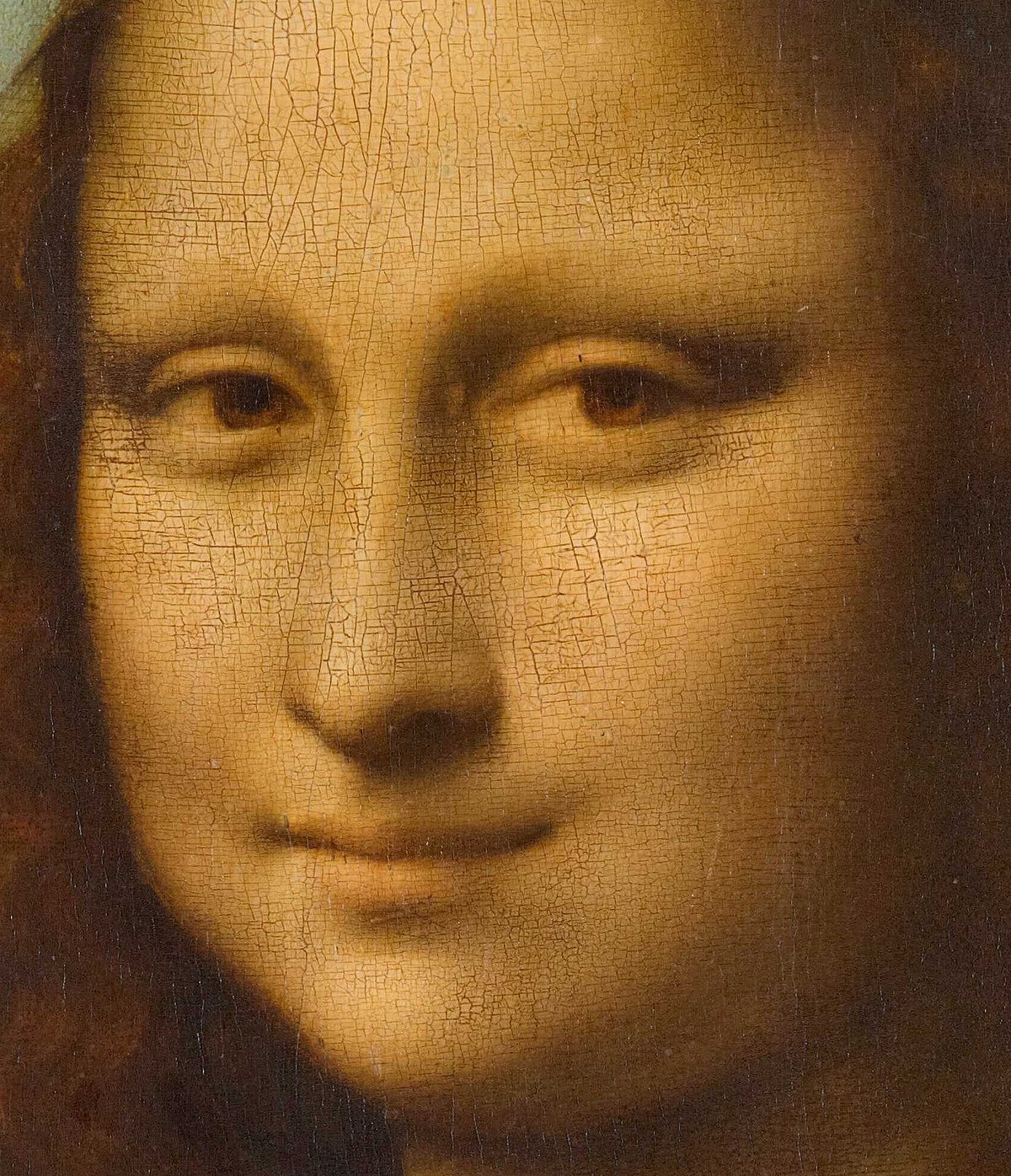 {Mona Lisa Sfumato Detail}
{Mona Lisa Sfumato Detail}
Acquired by King Francis I in 1519, the Mona Lisa has been a centerpiece of the Louvre since 1797. Its theft in 1911 by Vincenzo Peruggia only heightened its global fame, turning it into a cultural phenomenon [4]. Today, it holds a priceless status, so valuable that it cannot be insured [2].
Tips for Viewing:
-
Arrive early to beat the crowds.
-
The painting is displayed in Room 711 of the Denon Wing, behind bulletproof glass.
-
Photography is allowed, but you'll view it from a distance.
While the Mona Lisa captivates with its quiet allure, the next artwork, The Raft of the Medusa, grabs attention with its intense drama.
2. The Raft of the Medusa by Théodore Géricault
Théodore Géricault's The Raft of the Medusa (1819) is one of the Louvre's most gripping paintings. This massive canvas (491 cm x 716 cm) illustrates the aftermath of an 1816 shipwreck near Mauritania. Out of 150 people stranded on a makeshift raft, only 15 survived after 13 brutal days at sea. The painting captures the survivors signaling to a distant ship, teetering between despair and hope.
Géricault went to extraordinary lengths to ensure accuracy. He interviewed survivors and studied corpses at the morgue to portray the raw anguish and physical toll of the ordeal. The composition is striking: bodies form a pyramid-like structure, with the apex being a man waving desperately for rescue. Géricault’s use of light and shadow (chiaroscuro) heightens the emotional intensity, while the bold colors and dynamic arrangement bring the scene to life. This piece redefined historical painting by focusing on raw human emotion and storytelling.
@figure 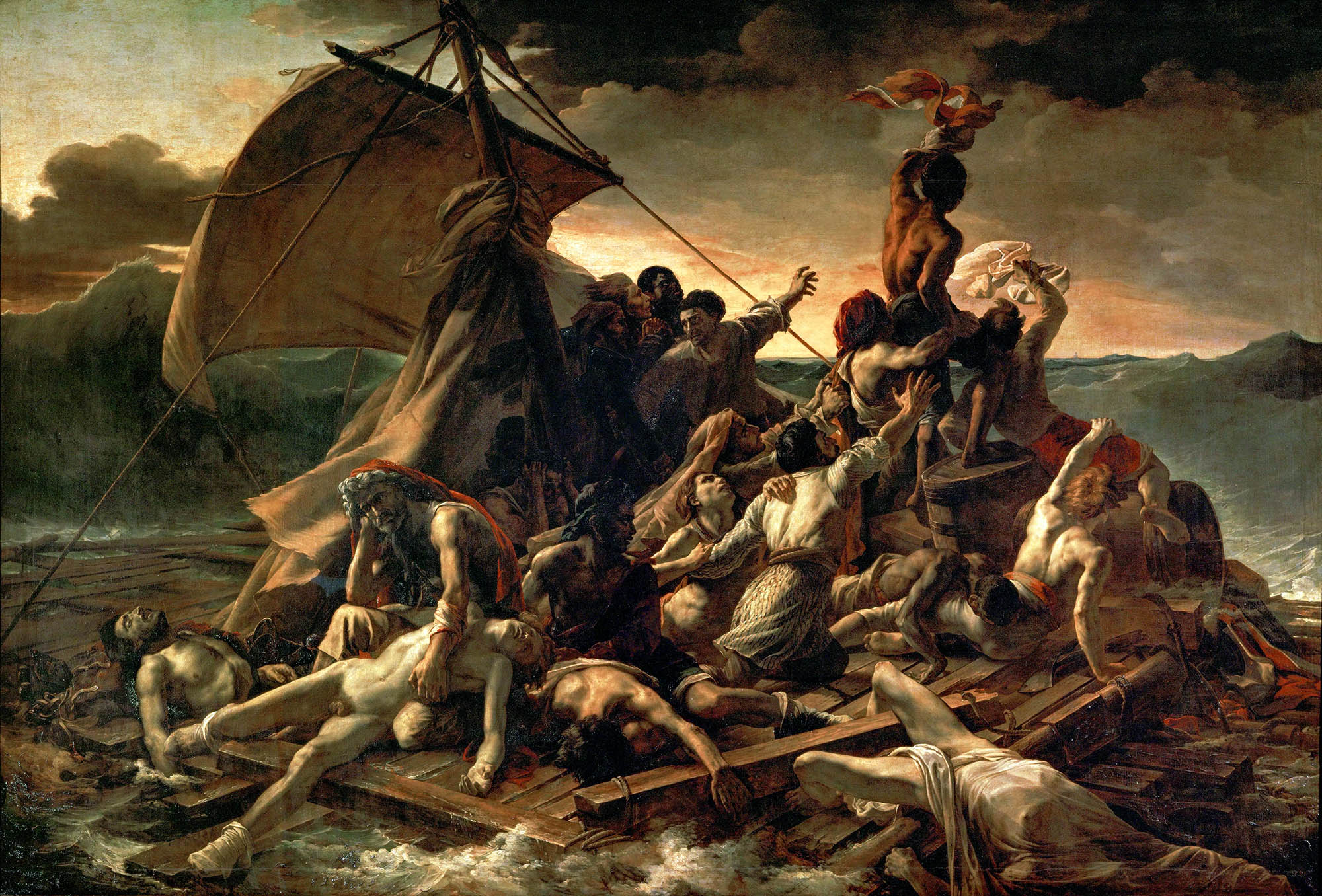 {Raft of the Medusa Chiaroscuro}
{Raft of the Medusa Chiaroscuro}
Viewing Tips:
-
Find it in the Denon Wing.
-
Pay attention to the survivors' expressions and how light and shadow convey their suffering and hope.
While this painting delves deeply into human endurance and tragedy, the next artwork, The Wedding at Cana, shifts the tone to celebration and abundance.
3. The Wedding at Cana by Paolo Veronese
Paolo Veronese's The Wedding at Cana (1563) is a massive masterpiece housed in the Louvre. Measuring 6.77 by 9.94 meters, it features over 130 finely detailed figures. The painting illustrates the biblical story of Jesus performing his first miracle - turning water into wine at a wedding feast.
Veronese blends the biblical tale with 16th-century Venetian life, dressing the figures in Renaissance clothing and including portraits of rulers and artists of his time. His use of bold colors and precise perspective brings the scene to life, pulling viewers into the extravagant celebration. The architectural details and landscape in the background showcase his talent for creating depth and atmosphere.
What to Look For:
-
Jesus and Mary placed centrally, surrounded by figures in vibrant Venetian attire.
-
Architectural details, including classical columns and a rich landscape.
-
Hidden portraits of historical figures, adding layers of intrigue.
How to Experience It:
-
Head to Room 711 in the Denon Wing to find the painting.
-
Step back to take in its enormous scale, then move closer to admire the intricate details.
-
Visit during quieter hours to fully enjoy the scene without distractions.
Originally created for the Benedictine monastery of San Giorgio Maggiore in Venice, this masterpiece now resides in the Louvre, offering visitors a glimpse into the grandeur of Venetian Renaissance art. Next, we turn to the iconic Winged Victory of Samothrace, a timeless symbol of grace and power.
4. The Winged Victory of Samothrace
@figure 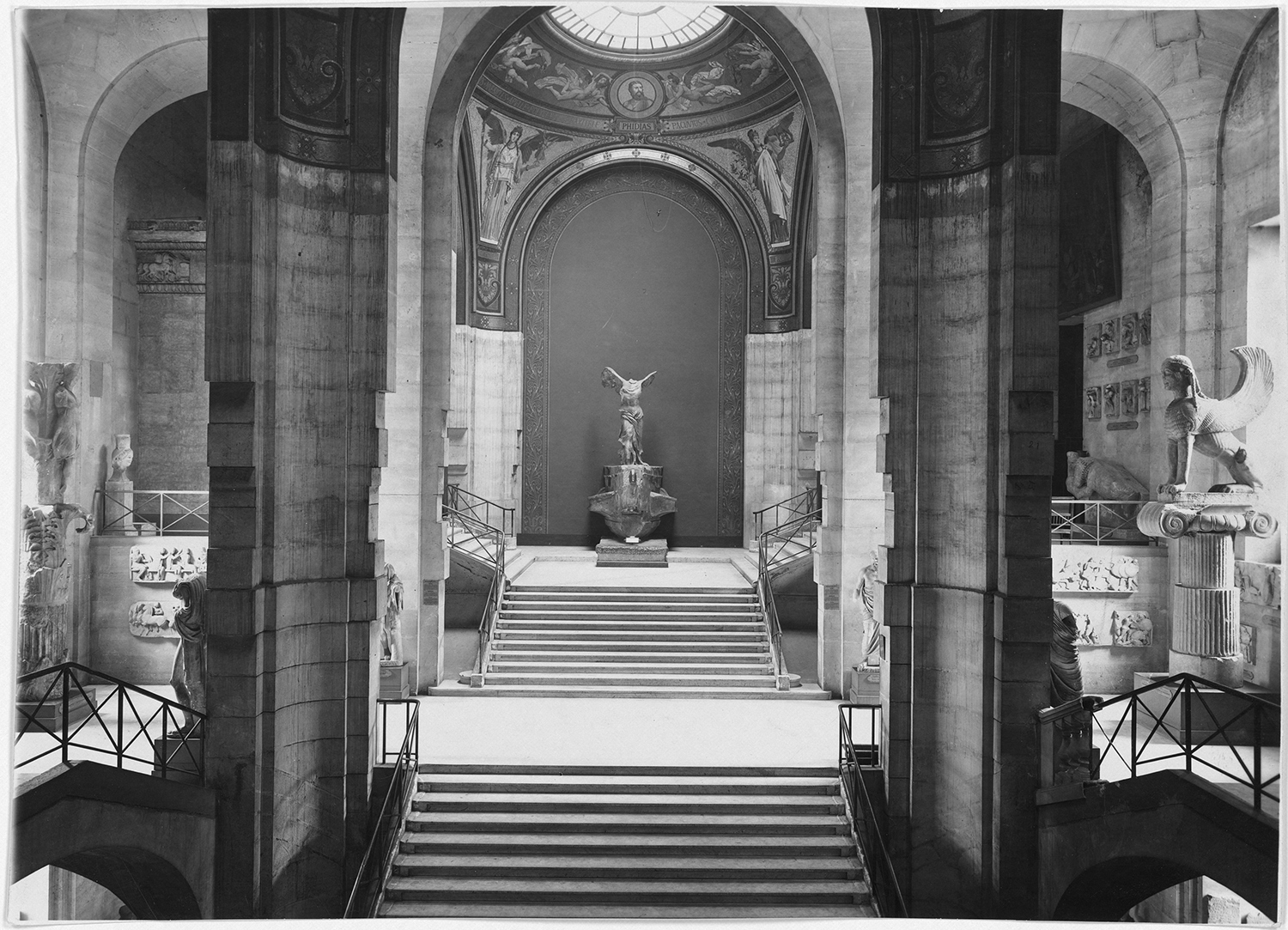 {Winged Victory at Louvre}
{Winged Victory at Louvre}
Perched at the top of the Daru staircase in the Louvre's Denon Wing, the Winged Victory of Samothrace commands attention as one of the museum's most iconic sculptures. This marble masterpiece from the early 2nd century BC portrays the Greek goddess Nike in a moment of triumph. Standing 8 feet tall and set on the prow of a ship, the figure seems alive with movement, its flowing drapery appearing to ripple in the wind [1].
Uncovered in 1863 on the island of Samothrace by French archaeologist Charles Champoiseau, this sculpture is a prime example of Hellenistic artistry. Its sense of motion, detailed drapery, and balanced proportions highlight the exceptional skill of ancient Greek sculptors. Since its arrival at the Louvre in 1884, it has become one of the museum's most celebrated pieces [1].
Originally adorned with vibrant colors, the statue's paint has faded, leaving its stunning craftsmanship in plain view. The wings, crafted separately and later attached, reflect the advanced techniques used by Greek artisans [1].
How to Best Experience It
To make the most of your visit:
-
Visit early in the morning to avoid heavy crowds.
-
Observe the statue from multiple perspectives, especially from the staircase below.
-
Take a close look at the intricate details of the drapery to appreciate the craftsmanship.
While the Winged Victory captures the energy of triumph, the Venus de Milo, coming up next, represents timeless elegance. Together, they highlight the Louvre's extraordinary collection of art that has shaped cultural history.
5. The Venus de Milo
The Venus de Milo is one of the most iconic sculptures in art history, admired for its timeless beauty and mysterious charm. Carved from marble between 130 and 100 BC during the Hellenistic period, it represents Aphrodite, the Greek goddess of love and beauty (referred to as Venus in Roman mythology) [1].
Unearthed in 1820 on the Greek island of Milos, the statue quickly became part of the Louvre's collection, where it remains a highlight to this day [1][3]. Though its arms are missing, the sculpture's flowing drapery, harmonious proportions, and detailed marble craftsmanship showcase the exceptional skill of Hellenistic artists.
Tips for Viewing
To make the most of your visit:
-
Visit during quieter times, such as early morning or late afternoon, to avoid crowds.
-
Observe the statue from multiple angles to fully appreciate its three-dimensional design.
-
Notice how the draped fabric adds a sense of movement to the otherwise still figure.
@figure 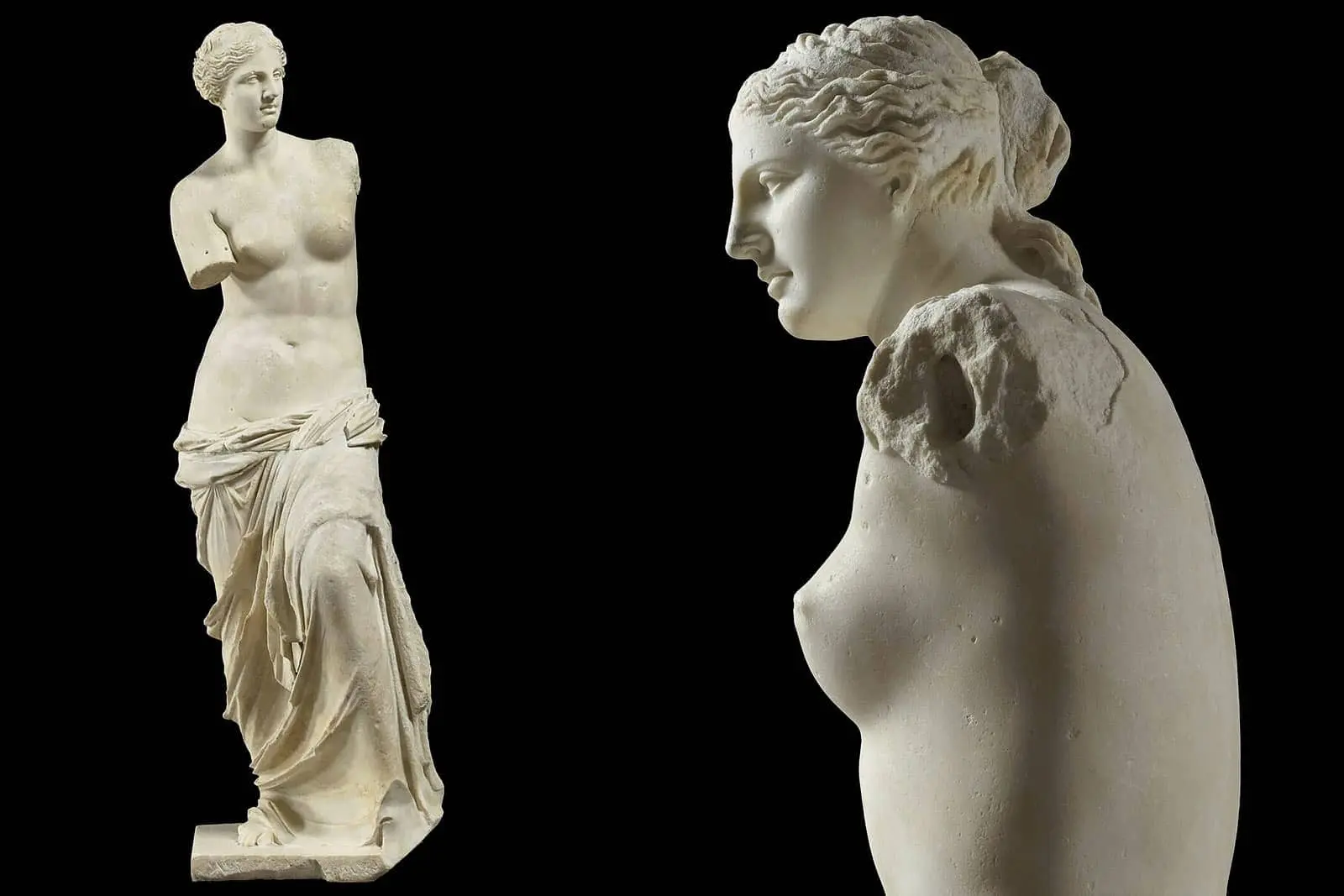 {Venus de Milo Angles}
{Venus de Milo Angles}
As a key piece in the Louvre's classical collection, the Venus de Milo offers a glimpse into the artistic achievements of ancient Greece and continues to captivate millions of visitors each year. The Louvre's efforts to maintain its condition, including regular cleaning and careful monitoring, ensure that this masterpiece remains preserved for future generations [1][3].
While the Venus de Milo captures the ideals of ancient Greece, the next artwork, The Coronation of Napoleon, highlights the splendor of a more modern age.
6. The Coronation of Napoleon
The Coronation of Napoleon by Jacques-Louis David (1806-1807) is a massive painting that captures the moment Napoleon Bonaparte crowned Joséphine on December 2, 1804, at Notre-Dame Cathedral in Paris. Spanning 9.8 by 6.2 meters, it features over 150 figures, with Pope Pius VII present, symbolizing the church's acknowledgment of Napoleon's authority.
David's attention to detail shines in every corner of the painting, from the imperial symbols like the eagle and scepter to the elaborate attire of the attendees. The composition places Napoleon at the center, with the lighting drawing your eye to him and Joséphine, emphasizing their importance.
Commissioned by Napoleon himself, the artwork was designed to solidify his status as emperor and highlight his transition from revolutionary leader to ruler. Its Neoclassical style and meticulous execution make it both a historical record and a masterpiece of its time.
Key Details to Notice
-
Napoleon and Joséphine: Napoleon is shown in his coronation robes, holding the crown over Joséphine, who kneels before him.
-
Pope Pius VII: The Pope's presence signifies the church's acknowledgment of Napoleon's authority, even as he crowns himself.
-
Imperial Symbols: Look for the scepter, eagle, and crown - classic markers of imperial power.
How to Best View It
-
Stand back to take in the entire composition and its grandeur.
-
Step closer to admire the intricate costumes and symbolic details.
-
Notice how the lighting directs your focus to the central figures.
This painting, displayed at the Louvre, remains a breathtaking depiction of power and ceremony. While it captures the splendor of Napoleon’s reign, the next artwork, The Virgin and Child with Saint Anne, offers a more personal and spiritual perspective.
@figure 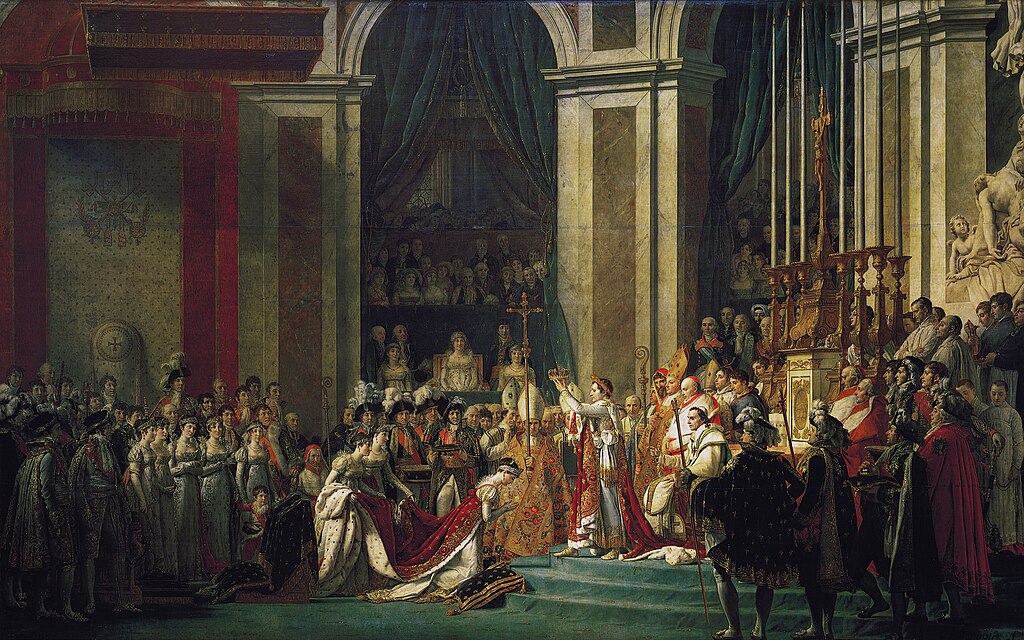 {The Coronation of Napoleon}
{The Coronation of Napoleon}
7. The Virgin and Child with Saint Anne by Leonardo da Vinci
Created between 1501 and 1519, The Virgin and Child with Saint Anne showcases Leonardo da Vinci's incredible skill in both technique and storytelling. Measuring 168 cm x 130 cm, the painting features Saint Anne, her daughter Mary, and the infant Jesus, arranged in a balanced pyramidal composition. Da Vinci's use of sfumato - a technique that creates a soft, almost hazy transition between colors - gives the figures a lifelike yet dreamlike quality.
@figure 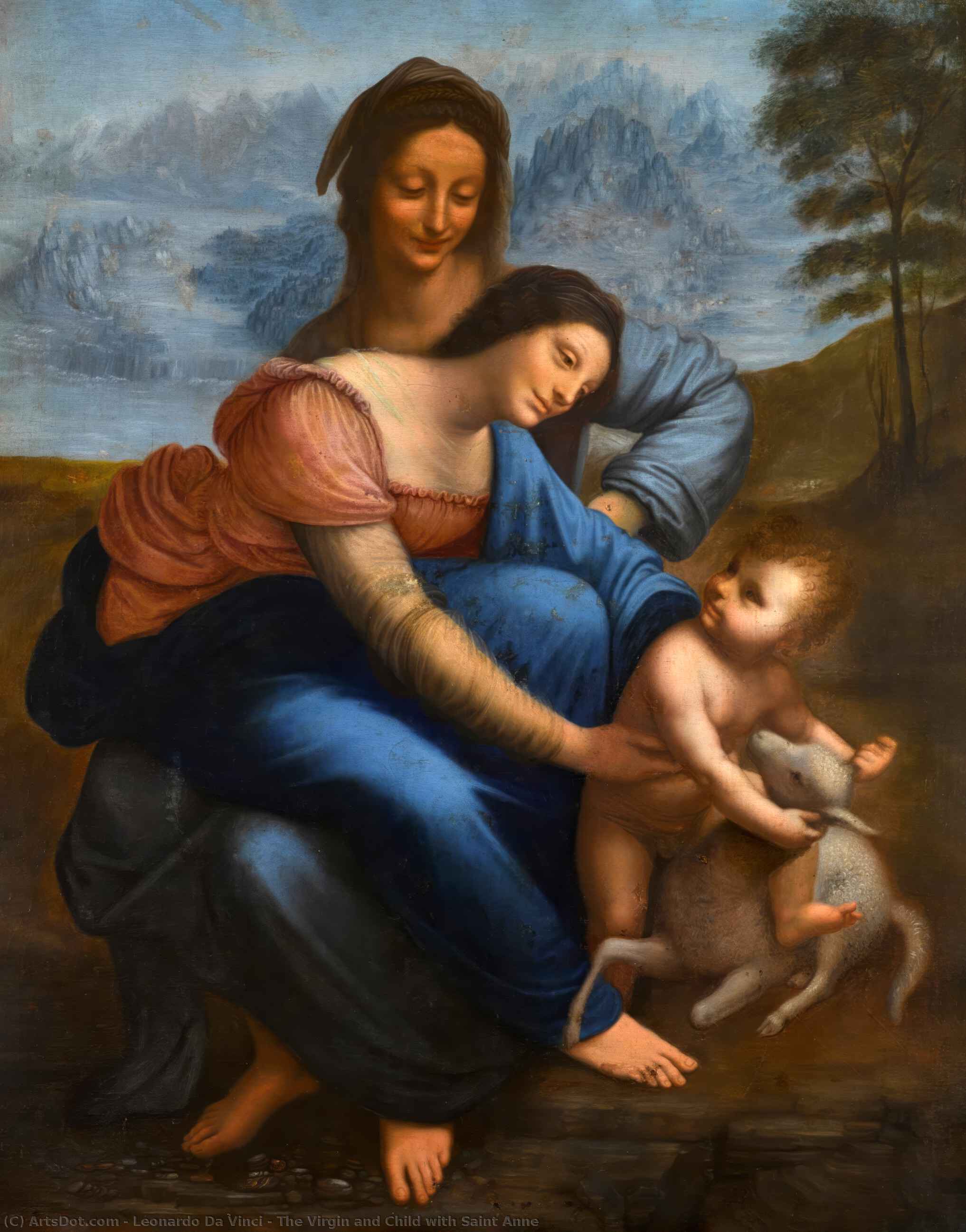 {Virgin and Child with Saint Anne}
{Virgin and Child with Saint Anne}
Key details stand out in this work: the triangular layout provides stability, the delicate lighting adds depth, and the tender interactions between the figures highlight their emotional connection. Unlike the Mona Lisa, which focuses on a single subject, this piece demonstrates da Vinci's ability to handle complex multi-figure scenes with ease.
Housed in the Louvre's Renaissance collection, the painting is a testament to da Vinci's lasting impact on art. Art historian Martin Kemp has praised its thoughtful composition and how it reflects the artist's mature style.
For the best viewing experience, stand about 3-4 meters away to fully take in the composition and intricate details. While this piece emphasizes da Vinci's talent for creating intimate, familial scenes, the next work, Saint Sebastian Tended by Saint Irene, shifts focus to dramatic contrasts of light and shadow.
8. Saint Sebastian Tended by Saint Irene by Georges de La Tour
Painted between 1634 and 1640, this work by French Baroque artist Georges de La Tour captures a deeply emotional moment. It shows Saint Irene tending to Saint Sebastian’s wounds after his martyrdom, depicted on a large canvas measuring 160 cm x 129 cm.
De La Tour masterfully uses chiaroscuro - a technique that plays with light and shadow - to draw focus to the scene's emotional core. A single candle lights the composition, creating dramatic contrasts that evoke a sense of compassion and quiet bravery. The interplay of light and shadow adds depth, while the rich colors and thoughtful arrangement of figures give the painting a striking intensity.
@figure  {Saint Sebastian and Saint Irene}
{Saint Sebastian and Saint Irene}
Though initially misattributed, this painting is now celebrated as a hallmark of de La Tour’s mature style. It stands out for its innovative use of light, not just for illumination but as a key storytelling element in Baroque religious art.
For the best experience, explore the painting from different distances to fully appreciate its details and composition. If possible, visit the Louvre during extended hours for a quieter viewing. While this candlelit scene showcases the emotional power of Baroque art, Michelangelo’s The Dying Slave offers a contrasting glimpse into the elegance and depth of Renaissance sculpture.
9. The Dying Slave by Michelangelo
Michelangelo's The Dying Slave (1513–1516), created for Pope Julius II's tomb, showcases his incredible skill in capturing human anatomy and emotion. The figure's twisted posture and detailed musculature express both a sense of struggle and calm, while the unfinished sections (non-finito) give us a rare glimpse into the artist's process, blending smooth details with raw, untouched marble.
@figure 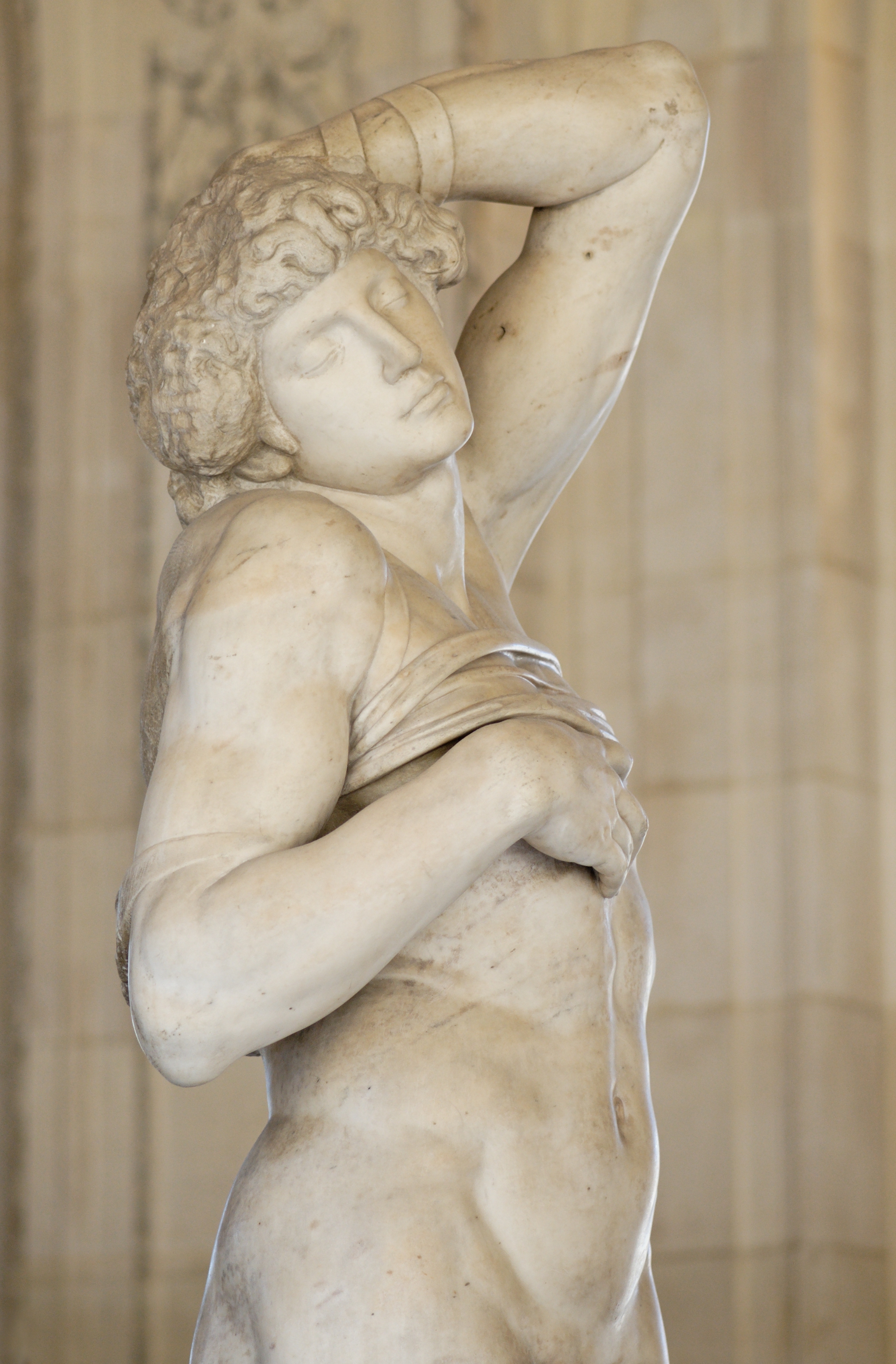 {Dying Slave Detail}
{Dying Slave Detail}
This sculpture, now part of the Louvre's Renaissance collection, highlights Michelangelo's unique approach to sculpture. The contrast between the polished and unfinished areas offers a deeper understanding of his technique and vision. Originally intended to be part of a larger series for the tomb, it stands as a powerful example of how Michelangelo could bring intense emotion to life through marble.
To fully appreciate this piece, take the time to view it from different angles. Notice how the interplay of light and shadow brings out its emotional depth, with the unfinished portions adding to its raw and poignant impact. While The Dying Slave captures the delicate balance between struggle and peace, the following masterpiece, The Seated Scribe, shifts focus to the remarkable realism of ancient Egyptian art.
10. The Seated Scribe
The Seated Scribe is a standout piece in the Louvre's Egyptian collection, showcasing the artistry and attention to detail of ancient Egyptian sculpture. Made from limestone and standing 21 inches tall, this statue portrays a scribe seated cross-legged, poised to write, with its colors astonishingly well-preserved.
The positioning of the hands suggests the scribe once held a papyrus sheet and brush, emphasizing the importance of literacy in ancient Egyptian culture. This piece not only reflects artistic skill but also offers a glimpse into the significance of educated individuals in that society.
@figure 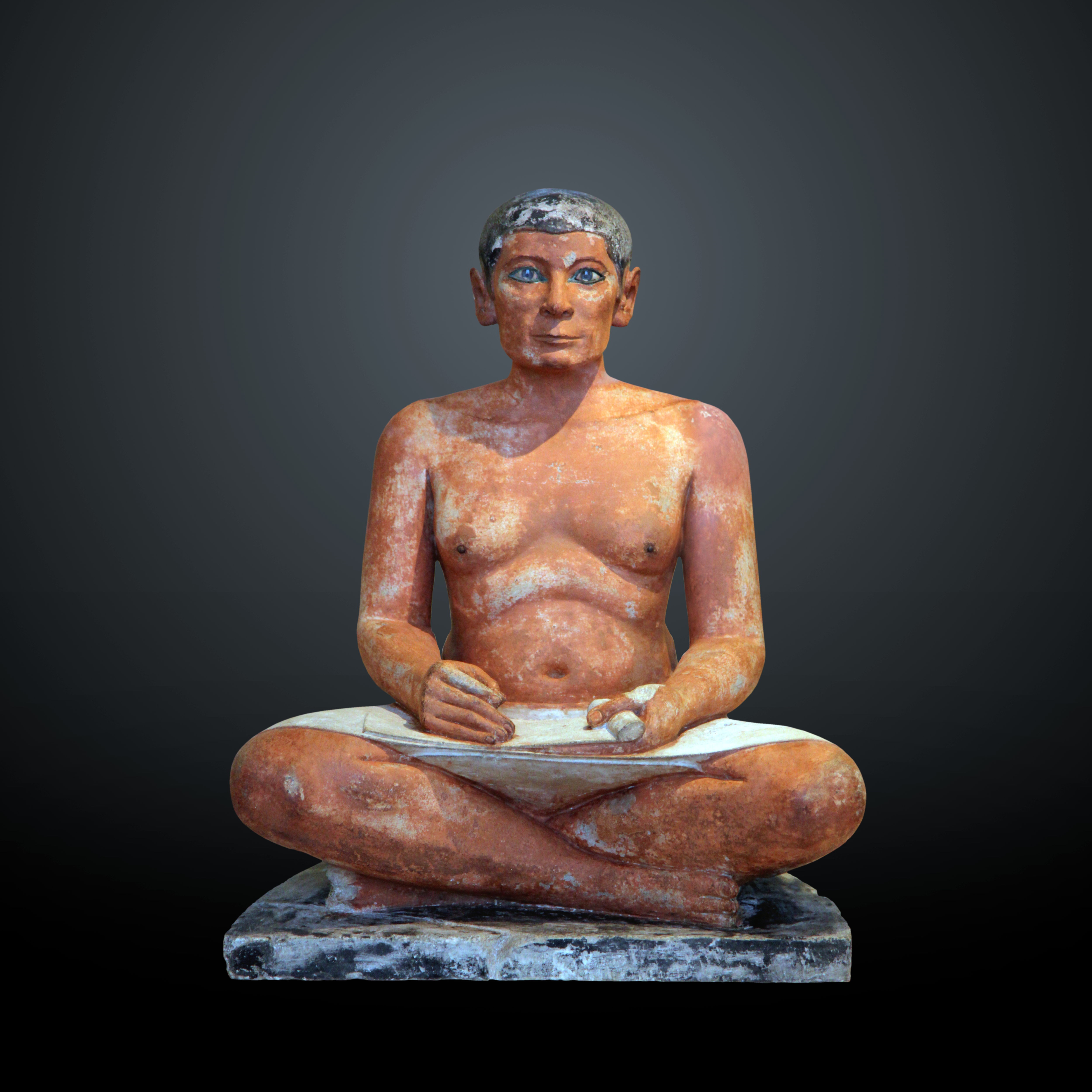 {Ancient Egyptian Scribe Statue}
{Ancient Egyptian Scribe Statue}
Take your time to view it from different angles to fully appreciate the intricate details. Displayed in the Louvre's Egyptian antiquities section, The Seated Scribe leaves a lasting impression with its lifelike quality and historical depth. While this sculpture highlights the precision of Egyptian art, the upcoming Liberty Leading the People shifts focus to the dynamic spirit of French Romanticism.
11. Liberty Leading the People by Eugène Delacroix
@figure 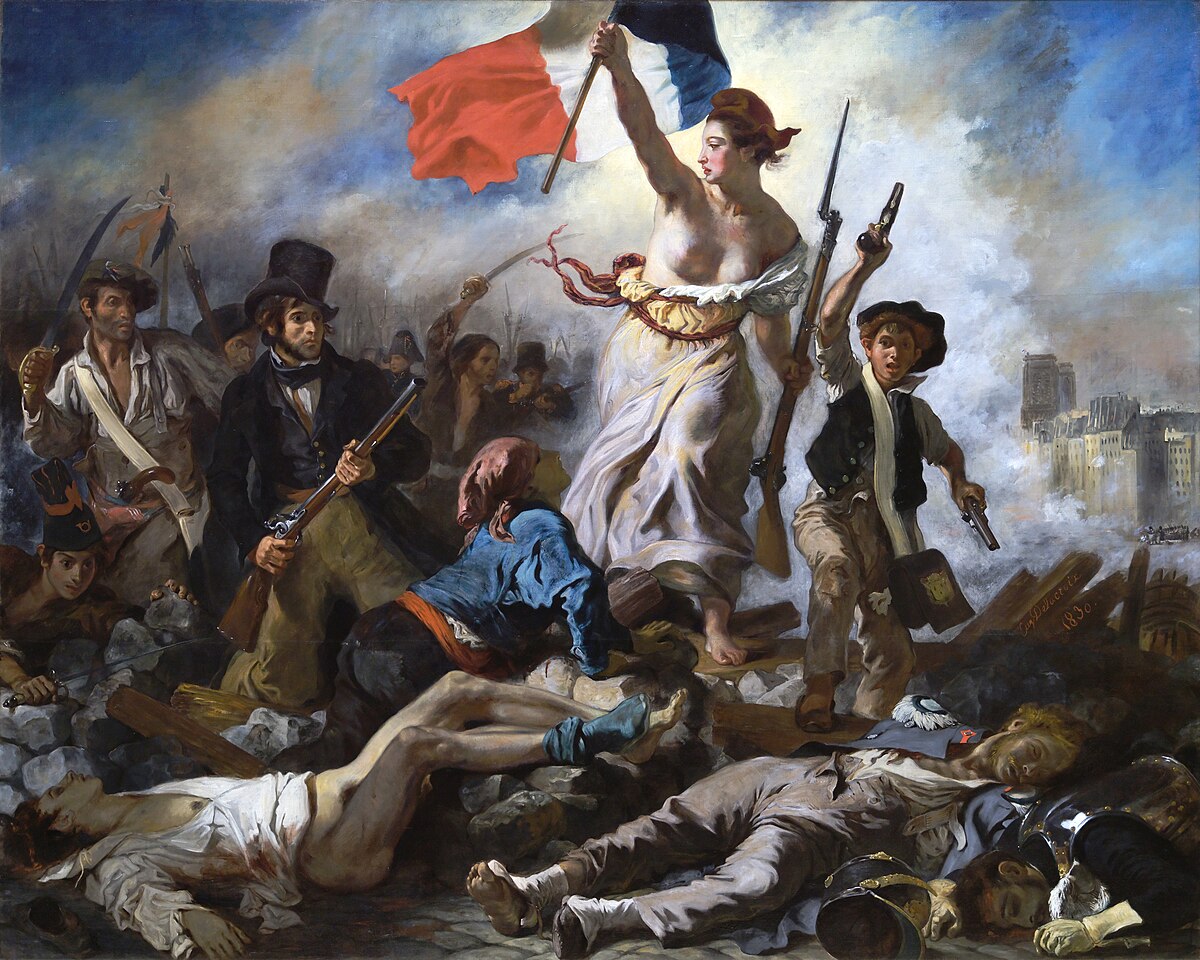 {Liberty Leading the People}
{Liberty Leading the People}
Created in 1830, Liberty Leading the People by Eugène Delacroix honors the July Revolution that toppled King Charles X. At its center is Liberty, depicted as a woman holding the French tricolor, advancing boldly through the chaos of battle. She represents freedom and national unity. Around her, Delacroix portrays individuals from various social classes, all united in their struggle for liberty. The fallen figures in the foreground serve as a stark reminder of the sacrifices made, contrasting with the revolutionaries' determined rise.
Delacroix's use of bold colors, dramatic composition, and his Romantic style amplifies the painting's emotional intensity. The interplay of light and shadow adds a sense of movement and urgency, making the scene feel alive and enduring. This masterpiece also had a lasting influence on later art movements like Impressionism and Expressionism, solidifying its role as a symbol of democratic ideals.
As part of the Louvre's French painting collection, this work is both historically and artistically significant. To fully appreciate it, take a step back to admire its sweeping composition, then move closer to explore the detailed expressions and textures. While Liberty Leading the People captures the energy of revolution, the next piece, The Lacemaker, offers a glimpse into the delicate world of craftsmanship.
12. The Lacemaker by Johannes Vermeer
Painted around 1669-1670, The Lacemaker is one of Vermeer’s most intimate works and a standout piece in the Louvre’s collection. Measuring just 24 x 21 centimeters, this tiny masterpiece showcases Vermeer’s talent for capturing everyday life with incredible detail.
The painting depicts a young woman fully absorbed in the delicate task of lacemaking. Her focused movements highlight themes of domestic skill and dedication. Vermeer’s expert use of light and shadow (chiaroscuro) adds depth, drawing attention to her hands as she carefully works with the threads. The inclusion of ultramarine blue, a pigment that was extremely expensive at the time, adds an extra layer of refinement to the artwork.
Unlike Vermeer’s other works that often include broader narratives, The Lacemaker hones in on a single, quiet moment. Every element, from the fine threads to the soft lighting, reflects Vermeer’s unmatched attention to detail. As one of only 35 surviving Vermeer paintings, it exemplifies his ability to transform ordinary scenes into timeless art.
This piece also offers insight into the Dutch Golden Age, when lacemaking represented both artistry and domestic values. Acquired by the Louvre in 1870, it remains a shining example of 17th-century Dutch genre painting. Observing it from different distances reveals its genius: from afar, the composition and lighting are striking, while up close, the intricate textures and fine details come to life.
While The Lacemaker celebrates the quiet beauty of domestic life, the next piece, The Oath of the Horatii, takes us into a world of dramatic civic duty and sacrifice.
@figure 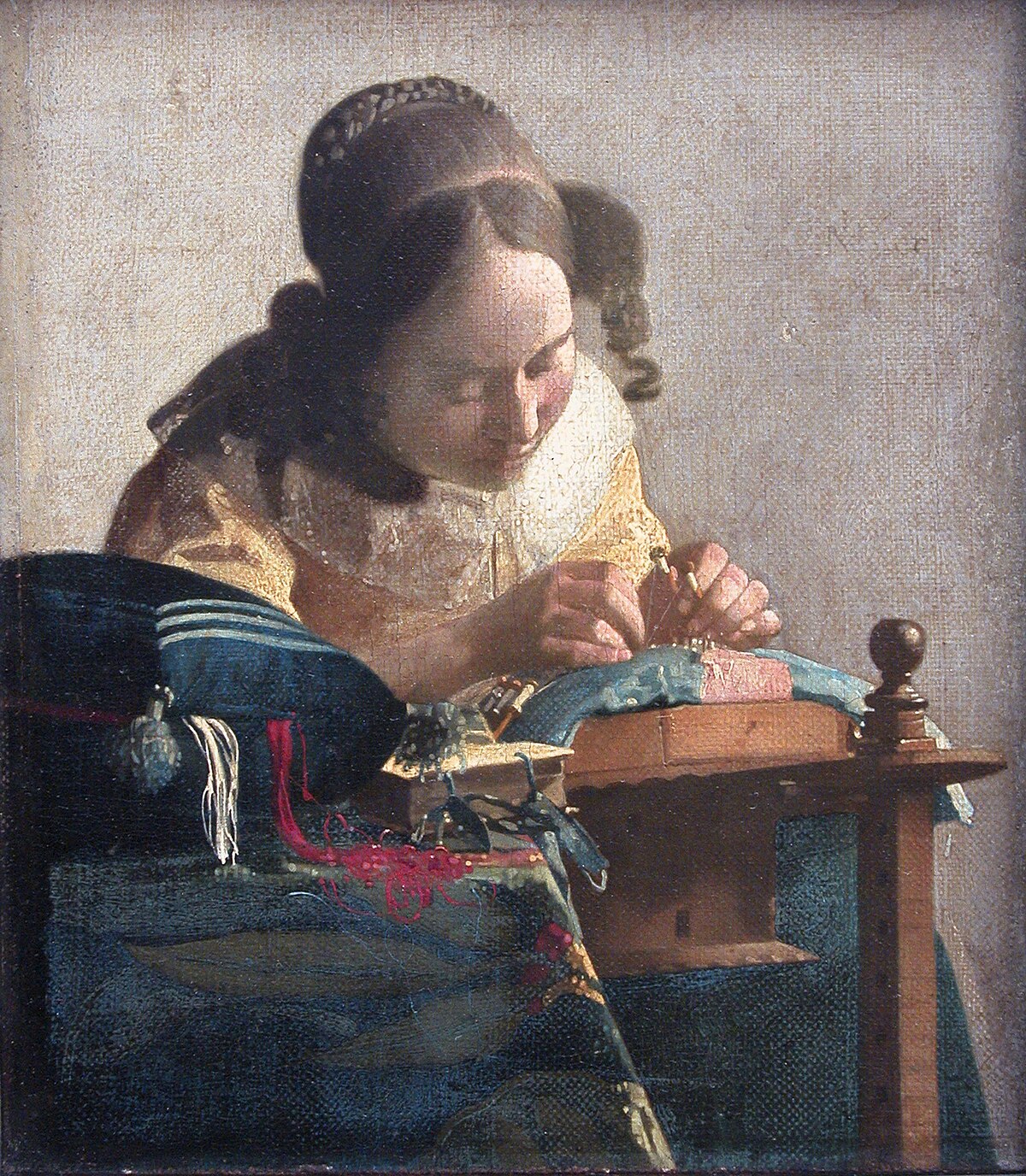 {The Lacemaker Detail}
{The Lacemaker Detail}
13. The Oath of the Horatii by Jacques-Louis David
Commissioned by King Louis XVI in 1784, The Oath of the Horatii showcases the shift towards Neoclassicism, moving away from the elaborate Rococo style. This large painting, measuring 3.3 by 4.2 meters, illustrates three brothers from the Horatii family pledging their loyalty to Rome in front of their father [1].
@figure 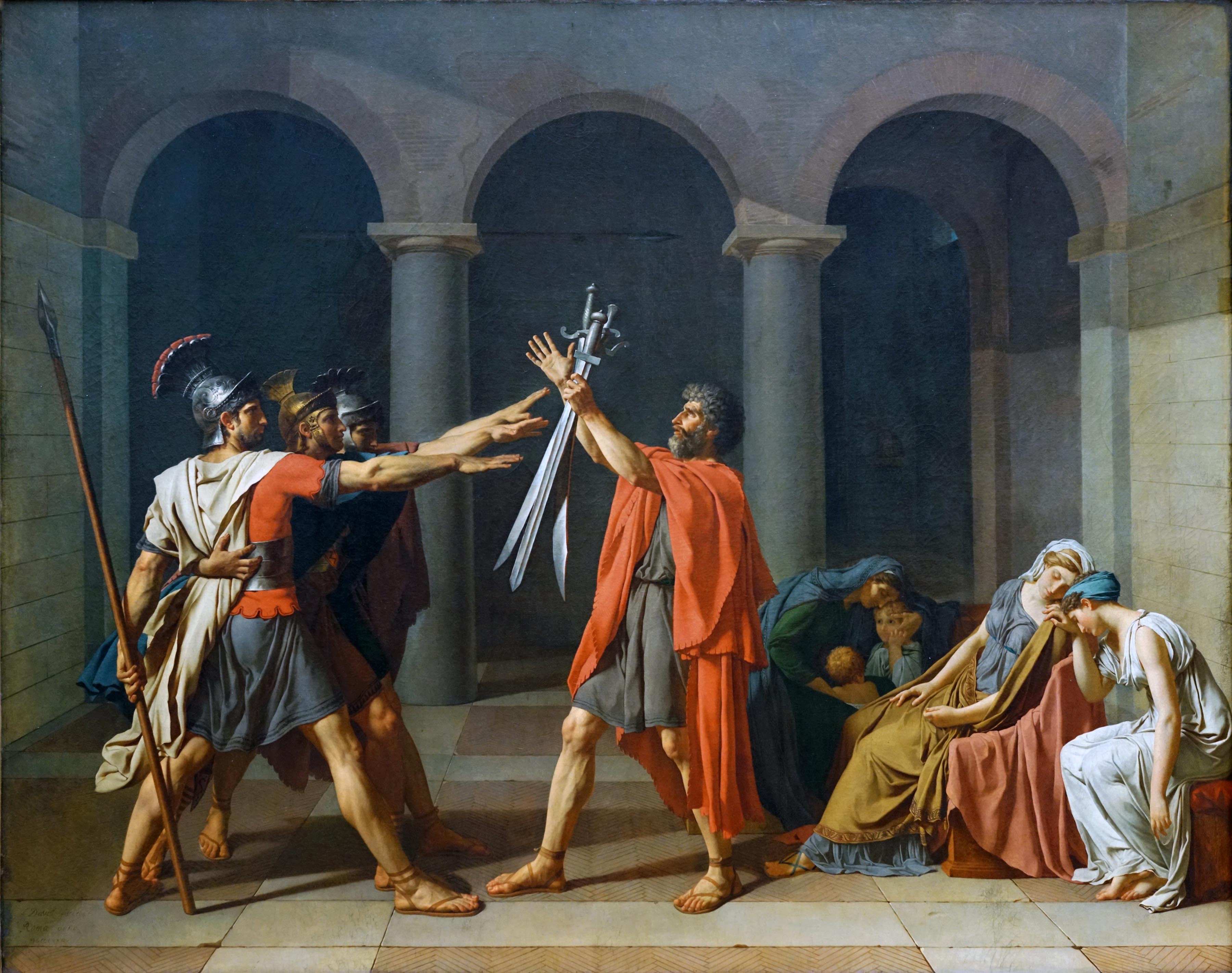 {Oath of the Horatii}
{Oath of the Horatii}
The artwork contrasts the brothers' strong, structured stances with the women’s emotional collapse, highlighting the intensity of the moment. David's use of sharp lighting and carefully arranged classical elements heightens the drama, drawing the viewer into this scene of sacrifice and commitment.
Added to the Louvre's collection in 1793, the painting has influenced countless artists, including Ingres, who borrowed from David’s classical approach. Its exploration of themes like loyalty and moral strength has ensured its lasting impact, making it a key piece in the museum's French painting collection.
Next, as you transition to The Madonna of the Rocks, you’ll see how Leonardo da Vinci tackled spiritual themes with a completely different yet equally impressive approach.
14. The Madonna of the Rocks by Leonardo da Vinci
Painted between 1483 and 1486, The Madonna of the Rocks is one of Leonardo da Vinci's standout works in the Louvre's collection. This Renaissance masterpiece, measuring 199 cm x 122 cm, portrays the Virgin Mary with the Christ child, infant John the Baptist, and the angel Uriel, all set against a mysterious rocky backdrop.
@figure 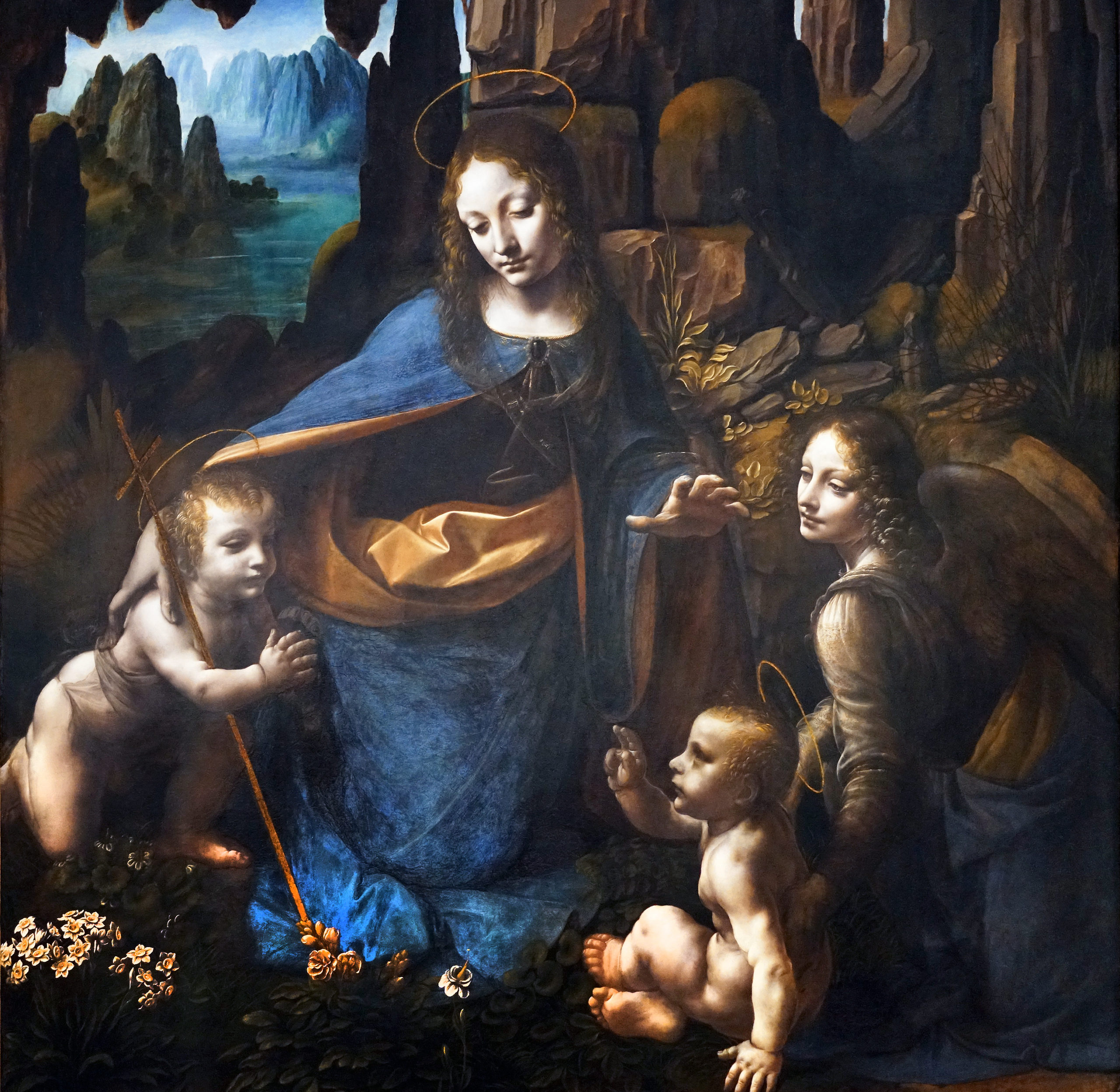 {Madonna of the Rocks Painting}
{Madonna of the Rocks Painting}
Leonardo's signature techniques are on full display here. The use of sfumato creates a soft, atmospheric haze, while the triangular arrangement of the figures brings a sense of harmony to the composition. The delicate balance of light and shadow adds depth and emotion to the scene. Every detail, from the tender expressions to the lifelike poses, reflects Leonardo's deep understanding of anatomy and human emotion.
What sets the Louvre's version apart is its distinction as the earlier of two paintings; the other is housed in London's National Gallery. The Louvre's piece is noted for its more spontaneous and expressive qualities. A 19th-century restoration uncovered the original colors, preserving Leonardo's intended palette and enhancing its visual impact.
This painting marks an important moment in Renaissance art, blending Leonardo's keen scientific observation with spiritual themes. Displayed alongside other works by the artist, it offers visitors a chance to explore his groundbreaking techniques and lasting impact on Western art.
While The Madonna of the Rocks highlights Leonardo's mastery of Renaissance artistry, the next piece, The Battle of San Romano, shifts the focus to Paolo Uccello's dynamic and vibrant style.
15. The Battle of San Romano by Paolo Uccello
Paolo Uccello's The Battle of San Romano (1438-1440) is one part of a triptych that captures the 1432 clash between Florentine and Sienese forces during the Wars in Lombardy. The panel at the Louvre highlights Uccello's groundbreaking use of depth and perspective, turning a historical battle scene into a technical masterpiece.
@figure 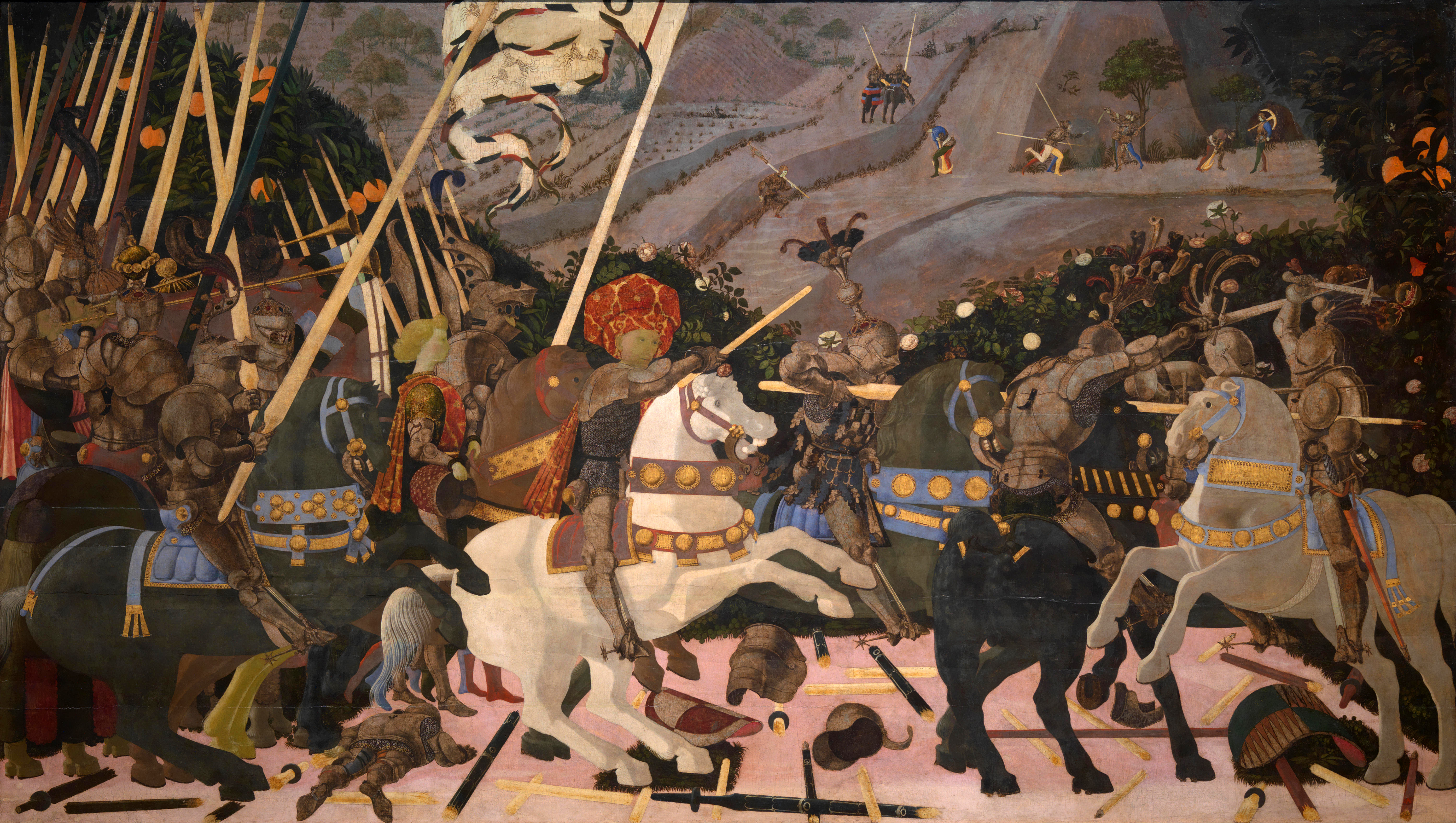 {Battle of San Romano by Uccello}
{Battle of San Romano by Uccello}
Uccello's attention to detail is apparent in every element: the precise patterns, the shine of the armor, and the dynamic movements of the horses. He carefully arranges fallen lances and armored figures to emphasize perspective, while the ornate decorations on horses and weapons reflect his meticulous craftsmanship.
"Uccello's paintings are like visualizations of the chivalric romances of the time, full of knights, horses, and armor." - Giorgio Vasari, The Lives of the Most Excellent Painters, Sculptors, and Architects [1]
This work, commissioned by the Medici family, served as a tribute to Florentine military strength. While the Louvre holds one of the panels, the others can be found at the National Gallery in London and the Uffizi Gallery in Florence. Uccello's innovative approach to perspective left a lasting impact on artists like Leonardo da Vinci and Michelangelo, bridging the gap between medieval styles and Renaissance precision.
To fully appreciate this piece, take note of its geometric patterns, the interplay of light on the armor, and the intricate spatial relationships. Positioned within the Louvre's Italian Renaissance collection, it offers a deeper understanding of both its artistic techniques and its historical significance.
As Uccello's work celebrates the precision of Renaissance geometry, the next masterpiece, The Lady with an Ermine, shifts the focus to Leonardo da Vinci's mastery of intimate portraiture.
16. The Lady with an Ermine by Leonardo da Vinci
Important Note: This painting is located at the Czartoryski Museum in Kraków, Poland, not the Louvre. For this reason, we'll move on to the next artwork in the Louvre's collection.
While The Battle of San Romano showcases the exacting geometry of the Renaissance, the next masterpiece, The Lacemaker by Nicolas Poussin, emphasizes the detailed elegance of Baroque art found in the Louvre.
17. The Lacemaker by Johannes Vermeer
Johannes Vermeer's The Lacemaker (1669-1670) is a small but striking gem from the Dutch Golden Age. Measuring just 24 x 21 cm, it portrays a young woman deeply focused on her lacemaking, highlighting Vermeer's exceptional skill in capturing light, shadow, and intricate details.
Using chiaroscuro, Vermeer brings depth to the scene, directing attention to the woman's hands and the delicate lacework. His choice of rich pigments like ultramarine blue adds elegance to the composition, while his meticulous depiction of textures showcases the precision that earned him a place among the great Dutch painters of the 17th century.
@figure 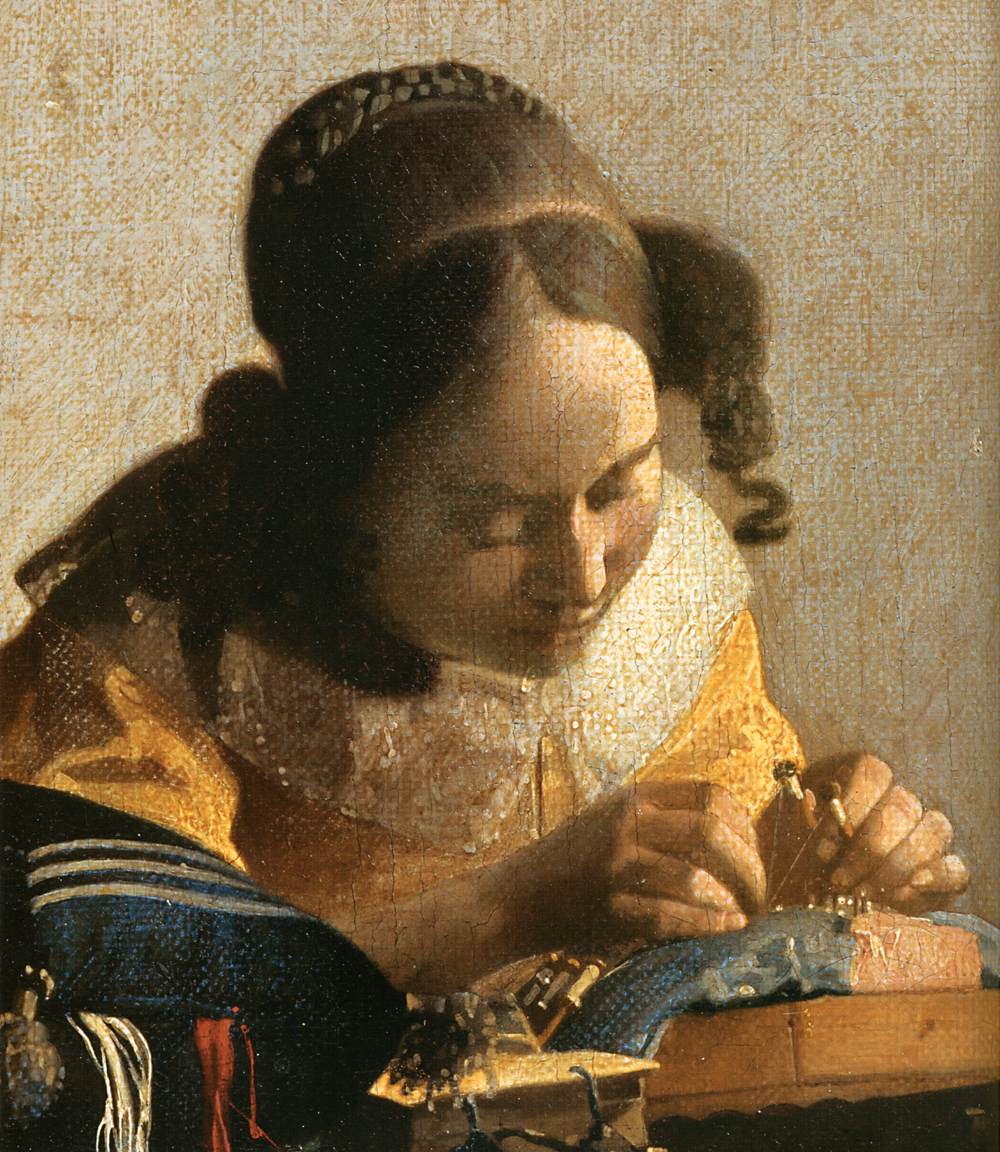 {Vermeer's Lacemaker Detail}
{Vermeer's Lacemaker Detail}
Though modest in size, this painting is a hallmark of Dutch Golden Age art, reflecting the period's interest in domestic life and skilled craftsmanship. Acquired by the Louvre in 1870, it remains a standout example of Dutch genre painting, blending artistic mastery with the cultural values of its time.
With its calm, reflective mood and flawless execution, The Lacemaker is an essential piece in the Louvre's collection. While this work celebrates the quiet beauty of everyday life, the next masterpiece takes us into the dynamic world of Baroque art with François Boucher's The Diana Bathing.
18. The Diana Bathing by François Boucher
Painted in 1742, François Boucher's Diana Bathing is a standout example of French Rococo art. This 57 x 73 cm masterpiece portrays the goddess Diana in a serene and private moment.
Boucher's skill in the Rococo style is evident in his use of soft, pastel tones and delicate brushwork. The painting beautifully captures the glow of Diana's skin and the lush details of the surrounding foliage. These elements work together to create a scene that feels both sensual and sophisticated.
Blending mythological themes with the tastes of the French court, Boucher's composition reflects the Rococo ideals of elegance and pleasure. The painting's placement within the museum's collection of 18th-century French art helps viewers see how French painting evolved during this influential era.
Diana Bathing highlights Boucher's role in shaping the Rococo movement. The piece embodies the style's hallmarks: flowing lines, mythological inspiration, and a focus on grace and beauty. Its intimate size and precise detail make it a perfect representation of Rococo art during the reign of Louis XV.
Next, we transition to the bold Neoclassical era with Jacques-Louis David's The Oath of the Tennis Court.
19. The Oath of the Tennis Court by Jacques-Louis David
Jacques-Louis David's The Oath of the Tennis Court (1791) portrays a pivotal moment from the French Revolution: the June 20, 1789, gathering where the Third Estate vowed to challenge the monarchy's absolute power. In the painting, David arranges the deputies in a semicircle, placing Bailly at the center as he leads the oath. The use of light and shadow adds emotional depth, emphasizing the unity and determination of the scene.
This piece reflects Neoclassicism through its focus on civic ideals and collective action. The raised arms of the deputies create a sense of movement and solidarity, pulling the viewer into the moment. Displayed in the Denon Wing alongside other Revolutionary-era art, the painting's scale and historical significance make it an essential work to experience.
David's meticulous composition and attention to psychological detail hint at his later role as Napoleon's official painter. This artwork stands as a striking example of how art can capture key moments in history, merging technical skill with revolutionary themes.
While The Oath of the Tennis Court embodies the revolutionary spirit, the next piece, The Napoleon III Apartments, shifts focus to the lavishness of a different era.
20. The Napoleon III Apartments
The Napoleon III Apartments provide a stunning look into the grandeur of France's Second Empire. Tucked away in the Richelieu wing of the Louvre, these state rooms blend Renaissance and Second Empire styles, showcasing some of the finest 19th-century French decorative arts. These apartments stand as a testament to the same level of artistry seen throughout the museum.
Covering 1,800 square meters, the apartments feature 18 rooms, each offering a window into the design and lifestyle of the Second Empire court. Key highlights include the extravagant Grand Salon, the majestic Throne Room, and the State Dining Room. These spaces are adorned with gilded moldings, glittering chandeliers, and period furnishings, all reflecting the wealth and sophistication of the era.
@figure 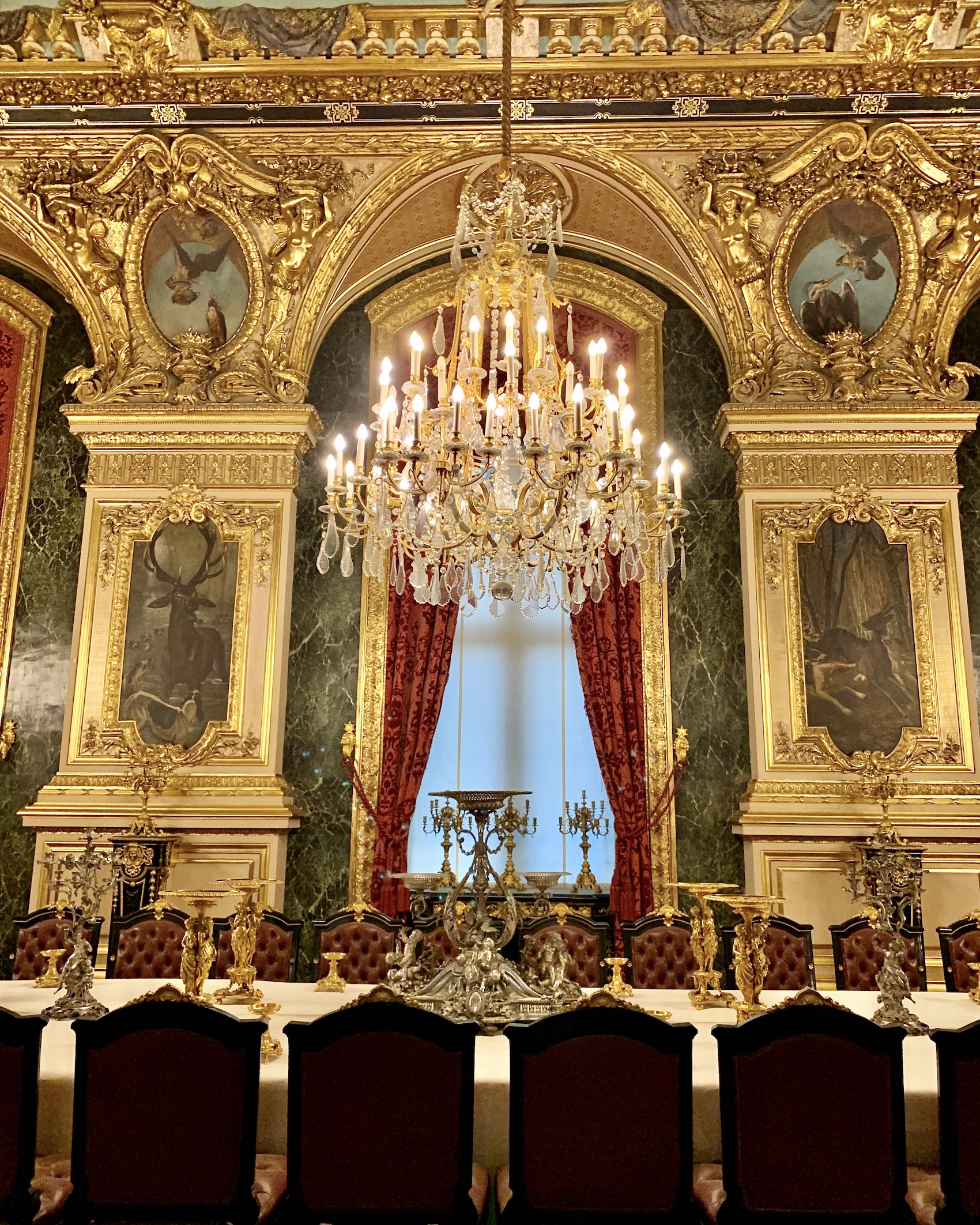 {State Dining Room, Napoleon III}
{State Dining Room, Napoleon III}
Restored in the 1980s to their original 19th-century glory, the apartments reveal much about the cultural and social customs of imperial France. From grand reception halls to private family quarters, the layout and decor of each room illustrate the strict hierarchy and protocol that defined court life.
Unlike traditional paintings or sculptures displayed on museum walls, these rooms themselves are a masterpiece of French decorative arts. For anyone passionate about art or history, the Napoleon III Apartments offer a rare chance to step into a space where architecture and history come together in breathtaking harmony.
These apartments, with their unmatched splendor, add a unique chapter to the Louvre's exploration of centuries of artistic and cultural legacy.
Conclusion
The Louvre stands as a remarkable journey through the history of art, showcasing over 550,000 works that span centuries. Among them, the 20 masterpieces highlighted here provide a glimpse into the museum's incredible variety and historical depth.
From the world-famous Mona Lisa to the opulent Napoleon III Apartments, each piece offers a unique perspective on art and history. These works not only demonstrate artistic skill but also serve as snapshots of different periods in human civilization. It's no wonder the Louvre attracts millions of visitors every year, cementing its reputation as a cultural landmark.
These highlights barely scratch the surface of the Louvre's collection, but they reveal the museum's role in connecting cultures and generations. Beyond preserving art, the Louvre fosters an appreciation for our shared artistic heritage, offering visitors a chance to explore humanity's creative journey.
For those eager to discover even more, platforms like Discover Art Around the World provide curated guides to other renowned museums, helping art lovers uncover treasures beyond the Louvre's walls.
These masterpieces are just the beginning, inviting visitors to delve deeper into the rich history and artistry housed within the Louvre's iconic halls.
FAQs
Why does the Louvre have the Mona Lisa?
The Louvre acquired the Mona Lisa in 1518 when King François I brought Leonardo da Vinci to France and purchased the painting. Since 1797, it has been a key part of the French royal collections and, later, the Louvre's collection [5][6].
Over the years, the Mona Lisa has become one of the most recognized artworks in the world. Today, it is housed in a secure, climate-controlled room and protected by bulletproof glass. Its theft in 1911 only added to its fame, cementing its place as a global cultural icon [2][5][6].
If you're planning to visit, timing is everything. Arriving early can help you avoid the biggest crowds [2]. While the Mona Lisa is undoubtedly the Louvre's most famous piece, it’s just one of the countless masterpieces that make this museum a must-visit for art enthusiasts.

